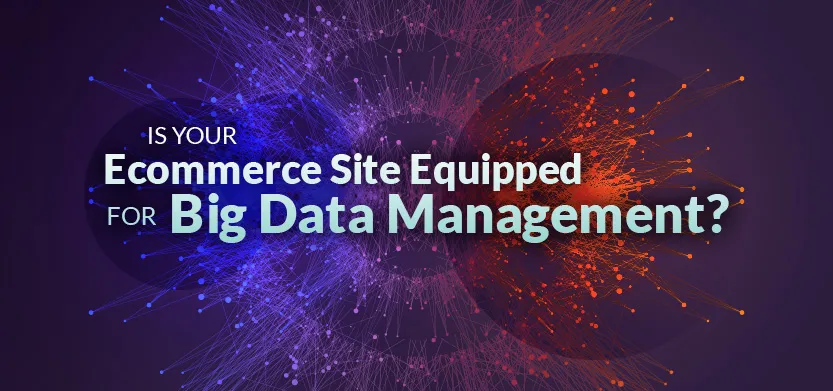
Author
David Weedmark
, Guest Writer
Posted in Digital Commerce, Software & Development
October 13, 2020
Is your ecommerce site equipped for big data?
Big data today is practically synonymous with ecommerce. Large companies like Amazon, eBay, Disney and Netflix are continuously expanding the amount of data they are able to capture and capitalize on new ways to track, analyze and use that data to improve customer satisfaction and to increase revenue. Of course, storing and analyzing ever-increasing volumes of data from more and more sources doesn’t come without some pain points. If your company’s growing pains are overshadowing the benefits of using big data, it may be time to consider making some changes to your platform.
How can you be sure you are ready for big data? Take a look at these key areas:
- Three types of big data — Know what kind of data you can expect and where that data comes from.
- Data management — Avoid pain points by being proactive about data protection and storage.
- Ecommerce data solutions — If your tech stack isn’t ready, what are your options for capitalizing on big data?
Big data — Three types
All of the types of data that are accessible to an ecommerce business can be categorized into three types: transactional data from your own website, click-stream data from other sources on the internet as and unstructured data that comes from online video streaming and voice calls.
Transaction data
Transaction data comes from exchanges between the customer and the ecommerce company. Traditionally, this data is tracked through the website itself, using cookies on the customers’ web browsers, so the data can be tracked and accessed whenever the customer returns to the website to personalize their experience.
However, this data can also come from software, like customer relationship programs, which track things like support calls or complaints, as well as data that comes from other websites or platforms. It’s not unheard of for this to involve billions of data points from millions of customers from hundreds of online stores and thousands of SKUs.
Click-stream data
This data comes from sources like online advertisements, social media platforms like Facebook and Twitter, blogs and comments. This data is used to predict customers’ interests and tastes, not only in what products they may be interested in, but which advertisements to serve them while they are online. Netflix, for example, gathers and analyzes over 1 billion data points from movie reviews and movies that are “liked” on social media to provide recommendations to its customers.
Video and voice data
Using image analysis software, big ecommerce companies can collect the unstructured live data that comes from video. Netflix, for example, uses video data to determine customer experiences, preferences, and to predict viewing habits. A range of large companies use data from customer service calls, not just to monitor likes and dislikes, but even to determine preferences based on language patterns, choice of words and use of slang.
Today’s pain points in big data management
As our access to data and the amount of data available both increase, new levels of complexity have come into play. More data from different sources have increased options but have also introduced a new level of complexity into the equation.
Data quality
Data needs to be accurate, timely and standardized before it can be used for analysis. When data is coming from multiple sources, this can be challenging. The question becomes how it is best to store this data for retrieval.
Storing data
Until recently this was often done with data warehousing, but a growing number of the top ecommerce businesses are no longer relying on this model alone and are augmenting it with data lakes. Data lakes are able to store unstructured data from a variety of different sources, like mobile apps, social media, IoT devices and proprietary automated analytics applications, where it can be accessed as and how needed, for analysis or for use by AI.
Having a wealth of data doesn’t do a company any good if you don’t have the resources to process it. Adding more people to the payroll isn’t usually a cost-effective option, but enhanced data management tools are. This is where APIs come in. Well-chosen APIs run automatically and pull data from the sources you specify and give you the analysis you need when you need it.
Data protection
Not only do customers expect that you will protect the data you give them, but 73 percent of those surveyed also want to know what you do with that data and they want to have some control over it. Ecommerce businesses should expect legislation in the future mandating more transparency in what companies do with data. This means not only will you have to protect it, but you will also need to track where it is shared and with whom.
New solutions for using ecommerce data
Off-the-shelf data management tools and services are unlikely to give you the resources you need to capture and manage millions of data points from multiple sources, without sacrificing speed, security or data integrity. Few large ecommerce companies, for example, can rely solely on data warehouses or data lakes but use a hybrid approach to manage both. Even managing cookies can be fraught with hazards when you collect data from multiple sources in real-time speed. Cookie fraud is usually undetected unless a company has the customized tools and expertise required to combat it.
If your current ecommerce platform isn’t giving you the options to capitalize on the opportunities big data offers, it may be time to take a fresh look at what is available to you. Acro Commerce’s experts can assist you in examining solutions for storing, managing and accessing the wealth of data you have access to, without adding new complexity to your business model. Reach out for a consultation today!
David Weedmark is an experienced web developer with a long and storied history in sales and online marketing. A published author, he enjoys playing with JavaScript — just for fun.
Author
David Weedmark
, Guest Writer
Posted in Digital Commerce, Software & Development
October 13, 2020


